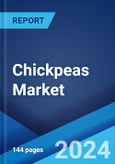Chickpeas, also known as garbanzo beans, refer to legumes that come under the family of Fabaceae and subfamily of Faboideae. There are two distinct types of cultivated chickpea, namely Desi and Kabuli. The desi type is grown in the Indian subcontinent while the Kabuli type is grown in West Asia and the Mediterranean region. Chickpeas are considered a good source of carbohydrates, proteins and include high levels of dietary fiber, vitamins and minerals. As a result, they offer numerous health benefits such as stabilizing blood sugar levels, maintaining muscle strength, aiding weight management, improving digestion and minimizing the risk of several chronic diseases such as diabetes and heart attack. Owing to this, they are added in a variety of dishes, like sauces, dips, soups and spreads.
Chickpeas are an economical source of dietary proteins for vegetarian and vegan consumers and are widely consumed in the form of dal in the Indian subcontinent. They are also used as a primary ingredient in hummus, a dip made with mashed chickpeas and other materials, which is popular in numerous parts of the globe. Moreover, consumers are nowadays opting for food products with high protein content owing to rising health awareness, which is further driving the product demand. With the prevailing trend of vegetarian meat substitutes, chickpeas are also being utilized for producing textured protein. Besides this, on account of the high cost and limited availability of higher protein sources like soybean, chickpeas have emerged as a low-cost feed additive. Some of the other factors boosting the growth of the market are population growth, increasing disposable incomes, and changing dietary patterns.
Market Segmentation
This report provides an analysis of the key trends in each sub-segment of the global chickpeas market report, along with forecasts at the global and country level from 2025-2033.Regional Insights
- India
- Australia
- Pakistan
- Myanmar
- Ethiopia
Competitive Landscape
The competitive landscape of the market is characterized by the presence of numerous small and large manufacturers who compete in terms of prices and quality. Some of the key players operating in the industry are:- Adani Wilmar Limited (AWL)
- Cargill Foods India
- AGT Food and Ingredients, Inc.
- BroadGrain Commodities, Inc.
Key Questions Answered in This Report
1. What was the size of the global chickpeas market in 2024?2. What is the expected growth rate of the global chickpeas market?
3. What are the key factors driving the global chickpeas market?
4. What has been the impact of COVID-19 on the global chickpeas market?
5. What are the key regions in the global chickpeas market?
6. Who are the key companies/players in the global chickpeas market?
Table of Contents
Companies Mentioned
- Adani Wilmar Limited (AWL)
- Cargill Foods India
- AGT Food and Ingredients Inc.
- BroadGrain Commodities Inc.
Methodology

LOADING...
Table Information
| Report Attribute | Details |
|---|---|
| No. of Pages | 149 |
| Published | February 2025 |
| Forecast Period | 2024 - 2033 |
| Estimated Market Value in 2024 | 21.5 Million Tons |
| Forecasted Market Value by 2033 | 32.2 Million Tons |
| Compound Annual Growth Rate | 4.6% |
| Regions Covered | Global |
| No. of Companies Mentioned | 4 |









